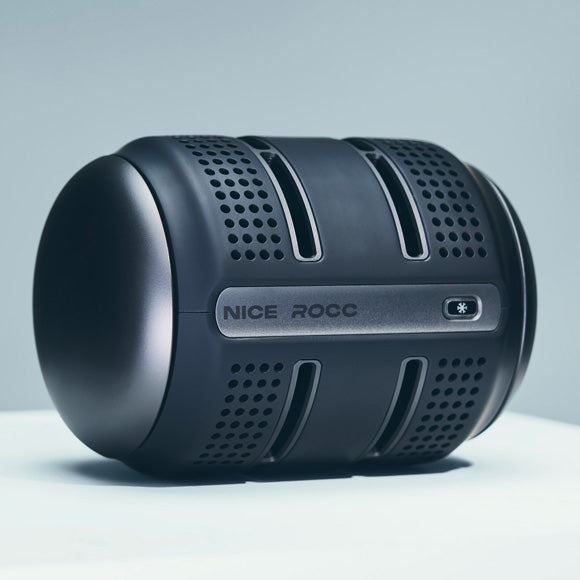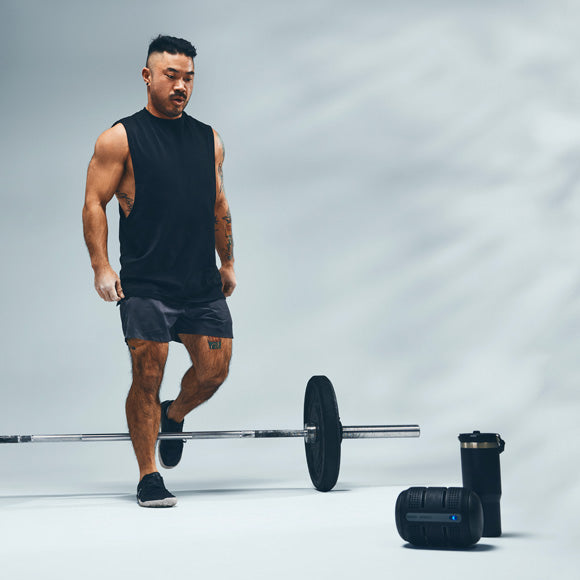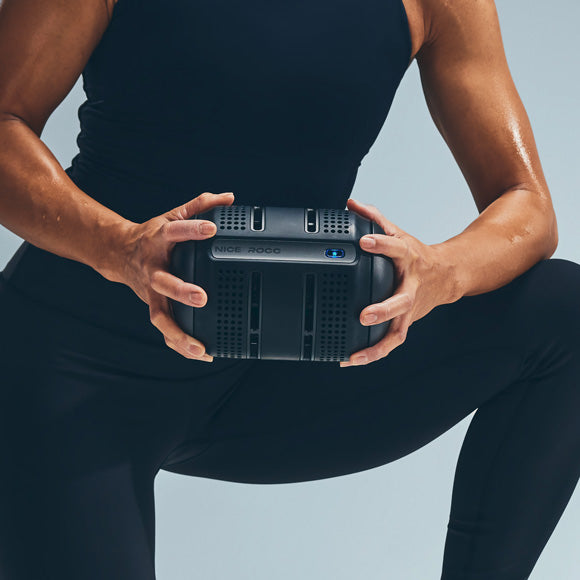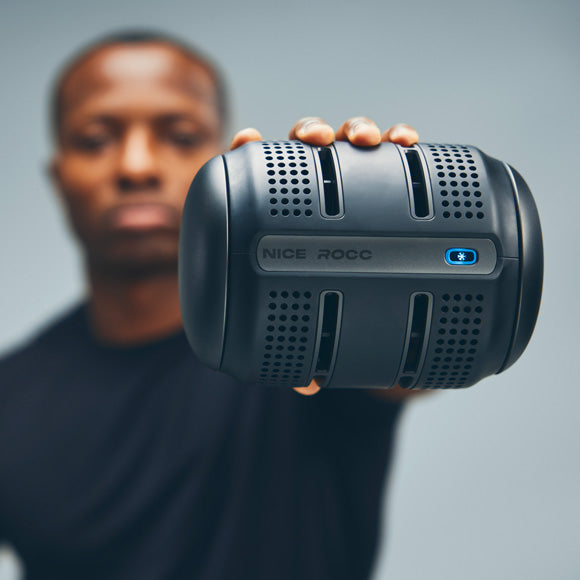From hockey players to tennis players and everything in between, a common challenge unites all athletes: the fight against excessive heat. As your core temperature creeps upward during intense exercise, your body’s internal mechanisms can slowly undermine your power, speed, and endurance. A growing body of evidence highlights Palming Cooling—the targeted cooling of the palms at moderate temperatures—as a game-changer in sports performance. By dialing in the cooling range to a precise 50–60°F, athletes can efficiently offload heat without risking the counterproductive effects of vasoconstriction.
NICE Recovery Systems, a leader in thermoregulation solutions, has harnessed the principles behind palming cooling to create the NICE ROCC device, which delivers stable, consistent cooling wherever your training takes you. In this article, you will learn why temperature control is so critical for peak athletic output, how to find the ideal cooling threshold, and the ways you can integrate palm cooling into your training or competition routine. Whether you’re an endurance specialist or a multi-sport athlete, understanding the science behind palm cooling temperature could be the key to unlocking better performances and quicker recoveries.
Why Is Temperature Regulation Essential for Athletes?
The Heat Factor in Sports
Regardless of discipline—distance running, field sports, or aquatic events—heat is an ever-present factor that influences performance. As you exert effort, your muscles convert chemical energy into mechanical force, generating heat in the process. Some level of warming is helpful; it makes your muscles more pliable and can facilitate enzyme function. However, too much heat can turn from friend to foe in seconds.
Overheating and Its Consequences
When the body’s internal temperature surpasses a certain threshold, multiple systems kick in to protect vital organs. Blood flow may be redirected from working muscles to the skin surface to promote cooling, undermining oxygen delivery where it’s needed most. Additionally, high temperatures can degrade muscle enzymes critical for energy production, resulting in reduced power and heightened fatigue.
Key Effects of Excessive Heat
-
Decreased Endurance: The cardiovascular system strains to manage thermoregulation, stealing resources from working muscles.
-
Impaired Cognitive Function: Overheating can lead to slower reaction times and dulled mental focus—critical in sports requiring rapid decision-making.
-
Higher Risk of Exhaustion: Dehydration and heat stroke become more likely, posing a real risk to both performance and overall health.
Palming Cooling Explained
Glabrous Skin and AVAs
Human palms (along with the soles of the feet and parts of the face) contain glabrous skin, which houses unique blood vessels called arteriovenous anastomoses (AVAs). These AVAs allow blood to bypass the usual network of capillaries, providing a direct channel between small arteries and veins. When you expose this skin to a 50–60°F surface, a high volume of blood passes through the cooled region, reducing core temperature more rapidly than other methods.
Why Not Use Ice-Cold Methods?
At first glance, dunking your palms in an ice bath or gripping a frozen pack may seem effective. Yet any temperature below about 50°F often provokes vasoconstriction—the narrowing of blood vessels—which impedes blood flow. Without adequate blood circulation, heat removal slows, sabotaging your cooling efforts. Moderate cooling, on the other hand, sustains active blood flow, drawing heat continuously away from overheated muscles and organs.
Optimal Palm Cooling Temperature: 50–60°F
The Science Behind the Range
A series of studies have reinforced the idea that a palm cooling temperature between 50 and 60 degrees Fahrenheit offers the ideal balance for heat removal. For instance, a 2015 paper in the European Journal of Applied Physiology reported that glabrous skin cooled in that moderate window improved both endurance and perceived exertion compared to colder interventions. By hovering just above the threshold that triggers vasoconstriction, you maintain robust circulation while still effectively pulling heat from the bloodstream.
Key Benefits of 50–60°F
-
Avoidance of Cold Shock: Athletes won’t experience numbness or pain commonly associated with extreme cold.
-
Steady Heat Extraction: Blood vessels remain dilated enough for continuous cooling.
-
Enhanced Comfort: In competitive scenarios, comfort matters—reduced discomfort translates into better focus and overall performance confidence.
The Role of Solid-State Technology
Traditional cooling methods—ice packs, water baths, or chilled towels—often cannot maintain a stable temperature. Enter the ROCC by NICE Recovery Systems. Using solid-state Peltier modules, the ROCC consistently holds a target surface temperature in the 50–60°F range. Its battery-powered design eliminates the need for ice or water, making it a reliable option for on-the-go athletes.
How Palm Cooling Enhances Athletic Performance
Sustained Endurance and Stamina
By preventing core temperature from climbing too high, the body’s energy pathways remain more efficient for longer. A 2019 article in the International Journal of Sports Physiology and Performance found that athletes incorporating moderate palm cooling noticed less fatigue in late-stage efforts, allowing them to maintain higher intensities in both aerobic and anaerobic tasks.
Improved Mental Sharpness
In many sports, mental acuity is as crucial as physical prowess. Overheating can slow cognitive processing and decision-making. Controlling internal temperature via the palms helps stave off the brain fog that often accompanies exertion in hot conditions, giving you an edge in fast-paced situations.
Accelerated Recovery
A tough competition or training session leaves residual heat in muscles and joints. Using palm cooling as part of your post-workout routine helps remove leftover heat and inflammation, setting the stage for faster healing and reducing the risk of chronic overuse injuries.
Reduced Risk of Heat-Related Illness
Sports professionals frequently reference the dangers of heat exhaustion and heat stroke. Precise temperature management—especially in hot climates—offers a proactive measure against these conditions. While palm cooling isn’t a substitute for proper hydration and medical care, it can serve as an additional buffer.
Who Stands to Benefit?
Endurance Runners and Cyclists
Long miles under the sun can raise body temperature to taxing levels. Brief palm-cooling breaks—like a minute or two every few miles—can keep you within a more comfortable thermal zone, preserving pacing strategies and overall stamina.
Field Sports: Soccer, Basketball, Tennis
Continuous sprinting, quick directional changes, and minimal rest periods mean these athletes heat up quickly. Halftimes or timeouts provide windows to reduce internal temperature, often yielding sharper second-half performance.
Combat and Martial Arts
Physical contact, heavy protective gear, and high-intensity movements generate extensive heat. Whether training or competing in a match, palm cooling can help fighters maintain speed and strength throughout multiple rounds.
Recreational Athletes
Even weekend warriors or fitness enthusiasts can use moderate palm cooling to combat hot gym environments or warm outdoor training sessions, extending the duration and quality of their workouts.
Practical Approaches to Palm Cooling Temperature
1. Pre-Activity Cooling
Strategically lowering body temperature before starting a high-intensity event helps you begin on a “cool foot.” This pre-emptive approach is particularly valuable in hot climates or when back-to-back heats in a track meet allow limited downtime.
2. Mid-Session Intervals
Short breaks—such as between sets or game breaks—are prime opportunities to apply palm cooling at the 50–60°F range. A 2021 review in the Strength & Conditioning Journal underscored how athletes prolong power output and reduce perceived exertion by integrating consistent cooling intervals.
3. Post-Event Recovery
Once the effort is done, an additional cooling period can speed the body’s return to baseline temperature. This approach is an essential part of a well-rounded recovery strategy that may also include proper hydration, foam rolling, or light stretching.
4. The ROCC Protocol
-
Duration: Typically 1–3 minutes of palm contact.
-
Indicator: A built-in haptic timer in the NICE ROCC signals optimal intervals.
-
Temperature Stability: The device reliably stays in the 50–60°F zone, preventing guesswork or time spent adjusting the cooling medium.
Ensuring Effectiveness: Common Pitfalls
-
Overly Cold Methods
Dropping below 50°F can cause vasoconstriction, limiting actual heat removal. Also, intense cold can be uncomfortable, discouraging consistent use. -
Inconsistent Application
Using moderate palm cooling sporadically may offer partial relief, but structured, regular use yields the most tangible improvements in performance. -
Ignoring Hydration
Without adequate fluids, the body’s natural cooling processes (like sweating and blood circulation) are compromised. Combine targeted palm cooling with a solid hydration plan for best results. -
Too Little Time
Submerging or contacting the palms for only a few seconds is rarely sufficient to remove significant heat. Aim for at least 30–90 seconds per interval, adjusting based on how you feel and the intensity of your activity.
FAQ Section
Q: Is Palm Cooling Effective for All Sports?
A: Whether you’re in endurance, explosive power, or skill-heavy sports, controlling body heat through the palms can help you maintain energy levels and mental focus.
Q: How Do I Know If the Temperature Is in the 50–60°F Range?
A: Specialized devices like the ROCC regulate temperature automatically. If you’re using a DIY approach, use a thermometer to ensure water or cooling packs remain in that moderate zone.
Q: Can Palm Cooling Replace Hydration or Shade Breaks?
A: No. Think of it as a complementary strategy. Water intake, rest in shaded areas, and palm cooling work together to keep your core temperature in check.
Q: What If My Palms Feel Uncomfortable or Numb?
A: That can indicate the cooling method is too cold. Adjust to a slightly higher temperature to avoid vasoconstriction and discomfort.
Q: Does Palm Cooling Also Improve Recovery From Injury?
A: It may assist in managing inflammation by reducing overall body heat, but it should not be a standalone therapy. Consult a medical professional for specialized recovery protocols.
Q: How Frequently Should I Use Palm Cooling During an Event?
A: Frequency can vary based on heat levels and intensity. Many athletes find using palm cooling every 15–30 minutes in endurance sports or during every rest break in team sports works well.
Bringing It All Together: Palm Cooling for Consistent High Performance
When it comes to athletic performance, many factors are within your control—training volume, nutrition, mental prep. Yet temperature management is often overlooked until it becomes a liability. With palming cooling at the correct temperature, you have a proactive tool to regulate internal heat, preserve energy, and maintain sharper focus over the course of demanding activities.
For athletes striving to excel, consistency is the name of the game. That’s why NICE Recovery Systems developed the NICE ROCC, a self-contained, battery-powered device that eliminates the need for ice or water refills. By maintaining the 50–60°F sweet spot, the NICE ROCC takes the guesswork out of cooling and lets you devote your full attention to the athletic tasks at hand. Plus, its haptic timer nudges you at intervals, so you’ll know exactly when you’ve achieved meaningful heat exchange.
External References
-
European Journal of Applied Physiology (2015). Research on moderate palm cooling improving athletic output.
-
International Journal of Sports Physiology and Performance (2019). Studies confirming fatigue delay via precise temperature control.
-
Strength & Conditioning Journal (2021). Review on structured, consistent cooling intervals optimizing performance.
-
Journal of Applied Physiology (2014). In-depth data on how heat impacts muscle enzyme efficiency.
(Disclaimer: Always consult a healthcare provider before making significant alterations to your training or recovery approach. Individual results may vary based on fitness level, genetics, and environmental conditions.)




